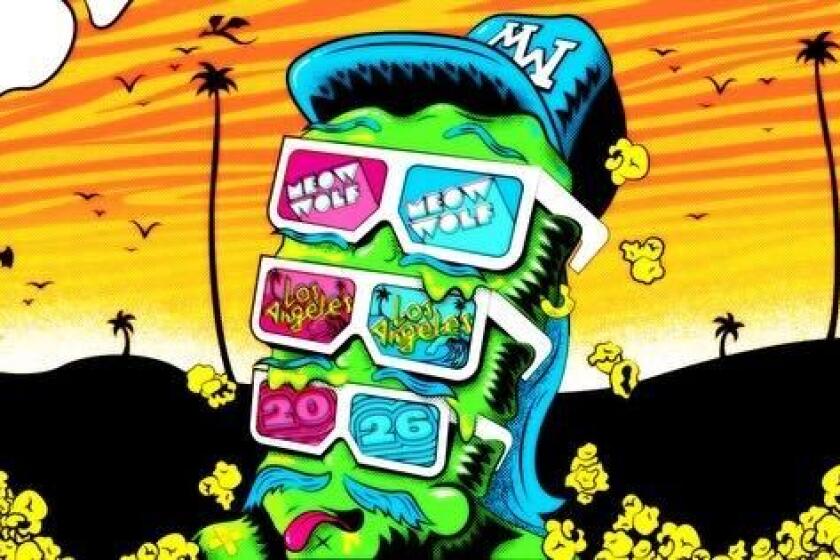ART REVIEW : Beth B’s ‘Amnesia’ Burns Into Our Memory : The New York-based artist’s one-minute video takes words of social intolerance from history and renders impossible the psychic action of forgetting.
Beth B’s one-minute videotape “Amnesia” (1992) is among the more devastating bits of agitprop to have been produced in recent memory. A harshly lit sequence of individual talking heads emerges from total blackness to recite a stark litany of statements about an unidentified group of people. The rapid accumulation soon grows ominous.
They spread disease.
They smell bad.
They take our jobs.
They are sexually perverted.
They slaughter sheep secretly.
Exactly who “they” might be is never declared. But then, it doesn’t have to be. The list of obvious candidates is long, and all answers are finally correct. “They” is anyone who is not “us.”
The statements, rather than having been invented by the artist, were researched and compiled from a variety of historical episodes of social intolerance. At their conclusion a final, silent image blares the word AMNESIA in a capital-letter crescendo across the television screen.
This visually arresting, conceptually concise videotape, which might even be described as perversely elegant in its calculated sense of chilly restraint, is a blunt attempt to create a work of art that will render impossible the psychic repression that allows forgetting. It works.
“Amnesia” has been broadcast on MTV. If you missed it, it may currently be seen at the Santa Monica Museum of Art in a small but diverse exhibition of recent mixed-media works by the New York-based artist.
*
As currently installed, the tape loses a bit of its visceral punch: A video projector magnifies the image into a big picture on the end wall of a narrow gallery, with a concomitant loss of the crisp clarity and shocking intimacy that comes from seeing “Amnesia” inhabit the screen of an ordinary television set. Still, it remains convincing evidence of Beth B’s unusual skill as an artist, especially in the mediums of film and video.
The show, which was organized by the Wexner Center for the Arts in Columbus, Ohio, also includes paintings, posters, photo-based works and a tabloid newspaper, modeled after the raunchy New York Post but ironically named Day of Hope. (The tabloid is filled with such “news” as an excerpt from the United Nations’ 1948 Universal Declaration of Human Rights.) Finally, an installation merging a sculptural environment with sound and a two-screen video projection dominates the main gallery.
“Under Lock and Key,” as this last is titled, employs a direct talking-head format akin to that in “Amnesia.” A video projector emits a visual soup of abstract imagery, which gives way to the sight of a handsome fellow on the left-hand screen. He makes random observations about human nature and then disappears.
The attractive if vaguely disconcerting fellow on the left alternates with assorted, slightly annoying talking heads on the right, each of which tells a painful story of having been personally assaulted earlier in life. Finally, the text spoken by the actor at the left is identified as a transcript taken from interviews with the suave serial killer, Ted Bundy.
Adjacent to this icy little theater of cruelty, which may be witnessed while seated on cold, hard, steel benches, a looming steel box invites viewers to open its heavy, lockable doors and enter one of four cramped chambers. Inside each is a steel bench affixed to the wall; an industrial light glows from the ceiling, an unpleasant drain is found in the floor.
There is also a voice. The recording (coolly spoken by actor Fred Ward) tells of the psychological effects of confinement. Taken from “In the Belly of the Beast,” the memoir of convicted killer (and Norman Mailer’s notorious protege) Jack Henry Abbott, it muses on the relationship between solitary confinement and death: “In death, the living thing ceases to experience.” Stubbing out experience, of course, is what an isolation chamber means to achieve.
It is also what a history of violent assault can do to the mind. B’s installation cleverly juxtaposes an interior meditation on isolation-as-death with external video stories of assault victims, whose confessional utterances to an assembled audience are meant to break the sense of isolation that typically shrouds such events.
As with the stunning “Amnesia,” part of the success of “Under Lock and Key” will be found in its refusal to preach and, by extension, to divide. Neither work assumes a condescending position of knowledgeable correctness from which moral superiority might be inferred. Both trust the ambiguity of art, not the certainty of moral posturing, to function as the more powerful polemic tool.
B’s paintings are less convincing. Appropriating racist and anti-Semitic images and words prominent in the fascist societies of 1930s Germany and 1940s Italy, she renders large caricatures of a black American soldier and a Jewish moneylender on unstretched canvas sewn into triptychs.
The intent seems to be to confront a usually hidden sanctification of evil, and thus defuse it, but the paintings are merely showy and vulgar. By contrast, Beth B’s sureness with the spare means of a camera and dialogue is bracing.
* Santa Monica Museum of Art, 2437 Main St., (310) 399-0433, through May 8. Closed Mondays and Tuesdays.
More to Read
The biggest entertainment stories
Get our big stories about Hollywood, film, television, music, arts, culture and more right in your inbox as soon as they publish.
You may occasionally receive promotional content from the Los Angeles Times.







